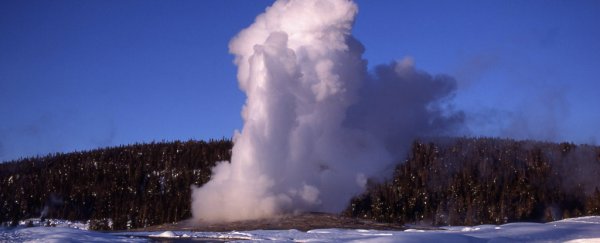Old Faithful in Wyoming is one of Yellowstone National Park's most famous geysers, regularly spewing out huge jets of boiling water and steam every 74 minutes on average.
The water that it shoots out gets up to 95.6 degrees Celsius (204 degrees Fahrenheit) as it hits the air outside, and the steam cloud can get above 177 degrees Celsius (350 degrees Fahrenheit) and reach 43 metres (140 feet) in height. But this week, the geyser appears to be erupting snow, due to unseasonably cold weather in the region.
You can see the crazy ice cloud that formed over the geyser a few days ago, when temperatures outside dropped to –18 degrees Celsius (0 degrees Fahrenheit):

So what's going on here? You'd expect boiling water blasting out of the geyser to melt the surrounding snow, not turn into it. But in cold temperatures, hot water actually freezes faster than cold water.
It's the same reason throwing tea into the air on a freezing cold day looks like this:
(Warning, don't try that at home without safety glasses and good coordination, because most people end up throwing the tea back in their face.)
While it might look like Old Faithful is erupting frosty snow straight out of its depths, what's actually happening here is that the hot water is instantly forming a cloud at it hits the air outside, and that cloud then begins to snow.
Boiling water condenses so quickly because it's constantly evaporating into steam, and that water vapour quickly clumps together in the frigid air outside, forming a cloud.
All of that water vapour eventually gets too heavy, just like in atmospheric clouds, and it begins to fall back to Earth as snow.
Meteorologist Mark Seeley from the University of Minnesota explained this phenomenon for Live Science back in 2011:
"When it's cold outside, there's hardly any water vapour present in the air, whereas boiling water emits vapour very readily that's why it's steaming. When you throw the water up in the air, it breaks into much smaller droplets, so there's even more surface for water vapour to come off of.
"Now, cold air is very dense, and this makes its capacity to hold water vapour molecules very low. There's just fundamentally less space for the vapour molecules. So when you throw the boiling water up, suddenly the minus 22 air has more water vapour than it has room for. So the vapour precipitates out by clinging to microscopic particles in the air, such as sodium or calcium, and forming crystals. This is just what goes into the formation of snowflakes."
It's pretty incredible stuff, and even better if you're lucky enough to see this reaction happening straight out of a bubbling hot geyser. Temperatures aren't often this low in Yellowstone, so it's a pretty rare occurrence, but one that will hopefully be visible a few more times this week at least.
But don't worry if you missed seeing it in the flesh, here's one of our other favourite experiments showing boiling water turning into snow:

